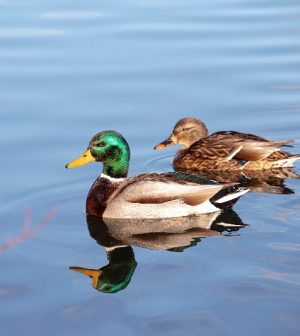- Navigating Your Midlife Crisis: Embracing New Possibilities
- City Raccoons Showing Signs of Domestication
- Mapping the Exposome: Science Broadens Focus to Environmental Disease Triggers
- One Week Less on Social Media Linked to Better Mental Health
- Your Brain Changes in Stages as You Age, Study Finds
- Some Suicide Victims Show No Typical Warning Signs, Study Finds
- ByHeart Formula Faces Lawsuits After Babies Sickened With Botulism
- Switch to Vegan Diet Could Cut Your Greenhouse Gas Emissions in Half
- Regular Bedtime Does Wonders for Blood Pressure
- Dining Alone Could Mean Worse Nutrition for Seniors
Avian Flu Virus Showing Up in NYC Wild Birds

The H5N1 avian flu virus has been discovered in a small number of wild birds in New York City.
The highly infectious and severe virus was detected in fecal samples in six New York City birds representing four different species, according to a report published May 15 in the Journal of Virology.
Bird flu is now widespread in wild birds around the globe, and it has been causing outbreaks in U.S. poultry and dairy cows, according to the U.S. Centers for Disease Control and Prevention.
“It is important to mention that, because we found H5N1 in city birds, this does not signal the start of a human influenza pandemic,” said researcher Christine Marizzi, principal investigator of the New York City Virus Hunters Program. “We know that H5N1 has been around in New York City for about two years and there have been no human cases reported.”
Only one human case of H5N1 bird flu occurred recently in the United States, involving a dairy worker in Texas, the CDC says.
However, researchers are worried that as bird flu spreads worldwide, the risk of it jumping into humans continues to grow.
The samples in the latest study were taken by local high school students working as paid interns for a wild bird monitoring program. The group collected more than 1,900 samples between January 2022 and November 2023.
New York City is a popular stopover location for migrating birds, researchers noted. Genetic analysis revealed that the H5N1 viruses found in the city belonged to a two different genotypes that are a mix of Eurasian and North American bird flu viruses.
“To my knowledge, this is the first large-scale U.S. study of avian influenza in an urban area, and the first with active community involvement,” Marizzi said in a journal news release.
“Birds are key to finding out which influenza and other avian viruses are circulating in the New York City area, as well as important for understanding which ones can be dangerous to both other birds and humans,” Marizzi added.
To minimize the risk of the avian flu jumping into humans, Marizzi said people need to keep their distance from wild birds.
“This also includes preventing your pets from getting in close contact with wildlife,” she added.
More information
The U.S. Centers for Disease Control and Prevention has more about avian flu.
SOURCE: American Society for Microbiology, news release, May 15, 2024
Source: HealthDay
Copyright © 2025 HealthDay. All rights reserved.










